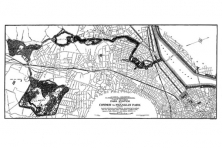Ramblas verdes
Barcelona (ES) – Winner
TEAM DATA
Team Representative: Eduard Balcells (ES) – architect urban planner; Associates: Valentin Kokudev (BG), Andrés Lupiáñez (ES), Balbina Mateo (ES), Marcos Ruiz De Clavijo (ES) – architects; Honorata Grzesikowska (PL) – architect urban planner
Contributors: Ma Li (CN) – architect; Joan Gallego (ES), Cristina Aznar (ES), Mike Swords (IE) – students in architecture
Travessera de les Corts 265 esc.A 6o2a, 08014 Barcelona – España
+34 686 464 185 – eduardbalcells@coac.net – www.eduardbalcells.com
See the complete listing of portraits here
See the site page here

B. Mateo, E. Balcells, V. Kokudev, H. Grzesikowska, C. Aznar, J. Gallego, M. Ruiz De Clavijo and A. Lupiáñez
INTERVIEW
1. How did you form the team for the competition?
We formed the team through advertisements and using the social media
2. How do you define the main issue of your project, insisting on how you answered on this session main topic: adaptability and urban rhythms?
The first issue for us was to link the huge existing public spaces and parks, between themselves and also with the project site, in order to clarify the system of public spaces at the North-East of the city and to make it more accessible both for the neighbours and for the broader city inhabitants. The second issue was how to reconnect the project site with the surrounding neighbourhoods, historically segregated by major infrastructures. The third issue was how to propose an urbanistic strategy that can work under uncertainty.
Our proposal answers these issues by proposing an urbanism thought from the public space. This enables us to reinforce the existing connections and to propose a minimal amount of optimal new ones. The connections are treated, when possible, as ecological regulators, that can help manage the urban microclimates and the water cycle, produce clean energy for local use and be a place for social interaction. Once the possibilities and potentials of the connections and the public spaces were defined, then we set up some basic rules for the built layer, which strive to provide the maximum adaptability in terms of the morphologies of the urban tissues, the building and housing typologies, and the ability to adjust to each economic cycle.
3. How did this issue and the questions raised by the site mutation meet?
For us, the main question raised by the site mutation is uncertain timing. We think that the project site has a privileged location: in front of what will become one of the major parks of the city and close to two of the largest other parks; situated beside one of the most successful commercial malls; served by two underground stops; and having the potential to become a joint between neighborhoods. We believe that these can be very good starting conditions, but the economic uncertainties also seem considerable. We address these uncertainties by proposing clear strategies and rules, but open and adaptable in their possible outcomes.
4. Have you already treated this issue previously and could you present some reference projects that inspired yours?
No, we had not treated this issue before. Some references for an urbanism thought from the public space and the ecology could be the “Boston Park System“ by F.L.Olmsted; Michel Courajoud’s landscape approach; or the local project of Riera de Sant Climent (Viladecans, ES) by Batlle i Roig.
For the typological variety and the incorporation of the existing potentials into a landscaped setting, we could take the “Chassé Terrain“ in Breda (NL), by OMA.
For the sustainability, social and smart cities strategies we could add the work of the Agència d’Ecologia Urbana de Barcelona and that of Jornet Llop Pastor in urban projects with a social emphasis, like the Rehabilitation of La Mina neighborhood in Barcelona (ES). Also the work on smart cities and the City Protocol, by Vicente Guallart.

5. Today –within the era of an economic crisis and sustainability– the urban-architectural project should reconsider its production method in time; how did you integrate this issue in your project?
We integrated this issue not by setting up a closed design, but a set of ambitious and easily phasable strategies, followed by some open design rules, that can adapt to every economic and demographic moment.
6. Is it the first time you have been awarded a prize at Europan? How could this help you in your professional career?
Yes, this is the first time we have been awarded a prize at Europan, and, as it is our first participation, we are very happy about it! Would there be an implementation phase that translates it into a commission, then winning Europan might mean to be able to establish a more sustained and continuous form of collaboration between us.